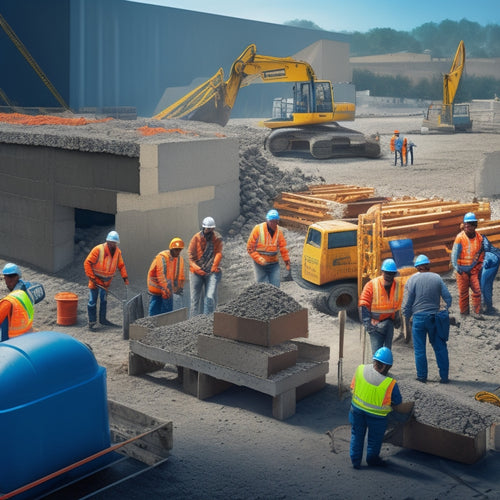
Measuring Tools for Accurate Concrete Block Construction
Share
You already possess a solid understanding of the importance of accurate measurements in concrete block construction, and it's vital to select the right tools to achieve precision and prevent costly rework. Laser levels, spirit levels, and precision straightedges guarantee accurate alignment and plumbness, while high-accuracy measuring tapes, digital angle finders, and concrete block thickness gauges provide precise measurements. Long-range distance measuring tools, compact measuring wheels, and specialized tools like inclinometers and block-to-block spacing measurers also play significant roles. By leveraging these essential tools, you'll be well-equipped to tackle complex construction projects with confidence - and uncover even more insights to refine your craft.
Key Takeaways
• Laser levels and spirit levels ensure accurate alignment and leveling in concrete block construction, preventing structural integrity issues.
• High-accuracy measuring tapes, digital angle finders, and concrete block thickness gauges provide precise measurements for block alignment and placement.
• Long-range distance measuring tools, such as laser distance meters, optimize measurements in large-scale projects, ensuring precise calculations and block placement.
• Block-to-block spacing measurers and accurate gap settings maintain uniform spacing, preventing structural weaknesses and ensuring load-bearing wall integrity.
• Specialized measurement tools, including advanced inclinometers, provide precise slope measurements, enhancing accuracy and reducing rework in construction projects.
Laser Levels for Precise Alignment
When constructing concrete block walls, you rely on laser levels to confirm precise alignment, as even slight deviations can compromise the structural integrity of the entire building.
To guarantee accuracy, you must perform regular laser calibration techniques, such as checking the device's leveling vial and adjusting the beam's vertical and horizontal planes.
Additionally, incorporating laser level maintenance into your routine is essential, as dirty or damaged lenses can affect the device's accuracy.
You should clean the lenses regularly and store the laser level in a protective case when not in use.
Digital Angle Finders for Walls
You'll also use digital angle finders to confirm accurate wall angles, particularly when working with complex block layouts or curved walls that require precise miter cuts. These advanced tools enable you to quickly and accurately measure angles, guaranteeing perfect wall alignment.
Digital angle finders, also known as digital inclinometers, provide precise readings of angles in degrees, minutes, and seconds, allowing for precise adjustments to your block layout.
When working with curved walls, digital angle finders are crucial for achieving accurate miter cuts. By measuring the exact angle of each block, you can verify a seamless joint that maintains the wall's curvature. Additionally, digital angle finders facilitate efficient wall alignment by providing instant feedback on angle deviations, allowing you to make adjustments in real-time.
To get the most out of your digital angle finder, it's important to calibrate the device regularly and follow the manufacturer's instructions. By incorporating digital angle finders into your concrete block construction workflow, you'll achieve precise wall angles, reduce mistakes, and ultimately produce high-quality walls that meet your clients' expectations.
High-Accuracy Measuring Tapes
Accurate measurements are critical in concrete block construction, and high-accuracy measuring tapes provide the precision needed to guarantee straight lines, square corners, and perfectly aligned blocks. As you work on your project, you'll want to choose a measuring tape that meets your specific needs. Here are some key considerations:
| Measuring Tape Variations | Tape Durability | Best Use Cases |
|---|---|---|
| Fiberglass tapes | High | General construction, rough framing |
| Steel tapes | Very High | Heavy-duty construction, harsh environments |
| Nylon-coated tapes | Medium | Interior finishing, trim work |
| Open-reel tapes | High | Large-scale projects, surveying |
| Closed-reel tapes | Medium | Small-scale projects, DIY work |
When selecting a measuring tape, consider the level of precision you need, as well as the environmental conditions you'll be working in. For example, if you're working outdoors in harsh weather, a steel tape may be a better choice due to its high durability. By choosing the right measuring tape for your project, you can ascertain accurate measurements and a successful outcome.
Concrete Block Thickness Gauges
With precise measurements already confirmed through the use of high-accuracy measuring tapes, the next step in concrete block construction is to verify the thickness of individual blocks, which is where concrete block thickness gauges come into play.
These specialized tools enable you to accurately measure the thickness of each block, guaranteeing it meets the required specifications. By using a concrete block thickness gauge, you can quickly identify any blocks that fall outside the acceptable concrete block tolerances, reducing the risk of structural weaknesses and guaranteeing a more stable construction.
When selecting a concrete block thickness gauge, look for one that can provide precise measurements to within 1/16 of an inch. This level of accuracy is vital, as even slight variations in block thickness can impact the overall integrity of the structure.
Additionally, consider a gauge that allows for block density measurement, as this can provide valuable insights into the block's composition and strength. By incorporating a concrete block thickness gauge into your construction process, you can guarantee that every block meets the required standards, resulting in a stronger, more durable structure.
Long-Range Distance Measuring Tools
When measuring distances exceeding 100 feet, long-range distance measuring tools, such as laser distance meters or ultrasonic rangefinders, become essential for guaranteeing precise calculations and accurate placement of concrete blocks in large-scale construction projects. You need to guarantee that your distance measurement techniques are accurate to avoid costly errors and rework.
Here's a comparison of popular long-range distance measuring tools:
| Tool | Range | Accuracy |
|---|---|---|
| Laser Distance Meter | up to 1000 ft | ± 1/16 in |
| Ultrasonic Rangefinder | up to 500 ft | ± 1 in |
| Total Station | up to 10,000 ft | ± 1 mm + 2 ppm |
| GPS Receiver | up to 10 miles | ± 1-5 ft |
| Survey-Grade EDM | up to 10 miles | ± 1 mm + 2 ppm |
When selecting a long-range distance measuring tool, consider the project's requirements, including the maximum distance to be measured and the desired level of accuracy. By choosing the right tool, you can guarantee accurate calculations and precise placement of concrete blocks, resulting in a high-quality construction project.
Spirit Levels for Perfect Horizontals
When you're building with concrete blocks, you need to make certain that your walls are perfectly horizontal and plumb.
You'll use spirit levels to check for any deviations from the horizontal plane, and to assure that your foundations are level and even.
Checking Plumb Lines
You use a spirit level to confirm that the concrete block walls are perfectly horizontal, as even slight deviations can compromise the structural integrity of the entire construction. This is vital, as walls that are off-plumb can lead to cracks, weaknesses, and even collapse.
To ascertain vertical alignment, you'll need to perform regular plumb line checks. Start by setting up a plumb bob, which will provide a precise vertical reference point. Then, use your spirit level to check the wall's alignment against the plumb bob line. Take readings at multiple points along the wall to verify accuracy.
Any deviations from the vertical will indicate a problem that needs to be addressed. By combining plumb bob techniques with spirit level readings, you can achieve precise vertical alignment checks.
Ensuring Level Foundations
A perfectly level foundation is essential to the stability and longevity of a concrete block structure, and spirit levels play an important role in guaranteeing this critical aspect of construction. You understand that even the slightest deviation from level can lead to foundation instability, which can have disastrous consequences.
To secure a sturdy foundation, you must verify that the soil is properly assessed and prepared. This involves evaluating the soil's density, moisture content, and load-bearing capacity to determine the most suitable foundation design.
Here are some key considerations when using spirit levels for perfect horizontals:
-
Verify the level's accuracy: Before relying on your spirit level, make sure it's calibrated and functioning correctly.
-
Check multiple points: Take readings at multiple points along the foundation to guarantee it's level in all directions.
-
Account for settlement: Consider the potential for soil settlement over time and adjust your foundation design accordingly.
Precision Straightedges for Edges
To guarantee accurate block alignment and plumbness, precision straightedges are essential for checking and verifying the edges of concrete blocks during construction. You'll want to invest in high-quality straightedges that provide precise measurements and won't warp or bend under heavy use.
When selecting a precision straightedge, look for one made from durable materials, such as aluminum or stainless steel, and consider the length and width you need for your specific project.
In addition to providing accurate measurements, precision straightedges also enable you to master edge alignment techniques. By using a straightedge to guide your saw or cutting tool, you can ascertain precision cutting methods that result in clean, straight cuts.
This is especially important when working with concrete blocks, which can be prone to chipping or breaking if not cut correctly. With a precision straightedge, you can confidently verify the edges of your blocks, guaranteeing a strong and level structure.
Block-to-Block Spacing Measurers
When constructing concrete block walls, you need to guarantee accurate gap settings between blocks to maintain structural integrity.
Block-to-block spacing measurers help you achieve this by providing consistent block alignment, which is critical for load-bearing walls.
Accurate Gap Settings
Set your block-to-block spacing measurer to guarantee consistent gaps between concrete blocks, as even minor deviations can compromise the structural integrity of your construction project.
To achieve accurate gap settings, you'll need to master gap measurement techniques and gap adjustment methods.
Here's what you should focus on:
-
Precise calibrations: Confirm your measurer is calibrated to the manufacturer's specifications to avoid inaccurate readings.
-
Consistent block preparation: Prepare each block face uniformly to confirm a snug fit and consistent gap measurements.
-
Regular gap checks: Perform regular gap checks to detect any deviations and make adjustments promptly.
Consistent Block Alignment
You guarantee consistent block alignment by using a block-to-block spacing measurer, a precision tool designed to maintain uniform spacing between concrete blocks and prevent structural weaknesses.
This tool guarantees that you're implementing the most effective block alignment techniques, which are essential for a sturdy structure. By maintaining accurate spacing, you're able to achieve ideal foundational alignment strategies, resulting in a robust and durable construction.
When you use a block-to-block spacing measurer, you'll notice a significant reduction in errors and inconsistencies.
This tool eliminates the risk of human error, allowing you to focus on other vital aspects of the construction process. With consistent block alignment, you can confidently build structures that meet the highest standards of quality and safety.
Advanced Inclinometers for Slopes
Two advanced inclinometers are specifically designed to provide precise slope measurements in concrete block construction: the digital inclinometer and the precision tilt sensor.
As a construction professional, you understand the importance of accurate slope measurements in ensuring slope stability and structural integrity. These advanced inclinometers offer high-precision readings, allowing you to make informed decisions about your construction project.
Here are some key benefits of using advanced inclinometers in concrete block construction:
-
Enhanced accuracy: Digital inclinometers and precision tilt sensors provide precise readings, reducing the risk of human error and ensuring accurate slope measurements.
-
Real-time data: These advanced inclinometers provide real-time data, enabling you to make swift adjustments to your construction project as needed.
-
Increased efficiency: With precise slope measurements, you can optimize your construction process, reducing the need for costly rework and ensuring a smoother project timeline.
Compact Measuring Wheels for Site
When verifying accurate slope measurements with advanced inclinometers, you can further optimize your concrete block construction project by utilizing compact measuring wheels for site measurements. These compact wheels offer several benefits, including increased portability, ease of use, and reduced measurement errors.
By incorporating compact measuring wheels into your site measurement routine, you can efficiently measure large areas, such as building perimeters, driveways, and parking lots, with precision and accuracy.
To maximize the compact wheel benefits, follow these site measurement tips:
First, verify the wheel is properly calibrated before use;
Second, maintain a consistent pace while rolling the wheel to prevent inaccurate readings;
And third, take multiple measurements to account for any potential errors.
Additionally, consider using compact wheels with built-in calculators or Bluetooth connectivity to streamline data collection and transfer.
Frequently Asked Questions
Can I Use a Regular Level for Concrete Block Construction?
When you're working with concrete blocks, you can't just use any regular level. You need a specialized level designed for the task.
There are different level types, such as laser levels, digital levels, and spirit levels, each suited for specific leveling techniques.
For concrete block construction, you'll want a level that provides precise readings and can withstand the rigors of the job site.
Invest in a high-quality level that's up to the task, and you'll guarantee accuracy and precision in your construction project.
How Often Should I Calibrate My Measuring Tools?
As you sharpen your skills, precision becomes your North Star.
When it comes to calibration frequency, you shouldn't be guessing. You should be scheduling regular check-ups for your trusty tools, ensuring they're as accurate as your attention to detail.
Aim to calibrate every 3-6 months, or after 100-200 uses, to maintain razor-sharp precision.
Proper tool maintenance is key to avoiding costly mistakes and ensuring your work stands the test of time.
What Is the Recommended Accuracy for Concrete Block Measurement?
When it comes to measuring concrete blocks, you should aim for a recommended accuracy of ±1/16 inch.
This tolerance level guarantees that your blocks fit together seamlessly, and your structure maintains its integrity.
To achieve this level of precision, you'll need to master advanced measurement techniques, such as using precision calipers and laser levels.
Can I Measure Concrete Blocks in Extreme Weather Conditions?
When you're working in extreme weather conditions, you'll face unique challenges.
Can you accurately measure concrete blocks in scorching heat or freezing cold? The answer lies in understanding temperature effects.
You'll need to account for thermal expansion and contraction to guarantee precision.
Don't let extreme conditions compromise your measurements.
Instead, adapt your approach to mitigate the impact of temperature fluctuations, and you'll achieve accurate results even in the most demanding environments.
Do I Need to Measure Every Single Concrete Block on Site?
You're wondering if you need to measure every single concrete block on site. The answer is, it depends.
If you're dealing with block size variations, it's essential to measure each block to guarantee accuracy and maintain construction site efficiency.
However, if you're working with uniform blocks, you can measure a representative sample and extrapolate the data.
Either way, precise measurements are key to avoiding costly mistakes and assuring a successful project.
Conclusion
You've made it through the gauntlet of measuring tools for accurate concrete block construction, and congratulations are in order - you're now officially a master of precision.
But let's be real, with all these high-tech gadgets, you're still just building a wall.
A really, really straight wall.
So, pat yourself on the back, but don't get too carried away - after all, it's just concrete blocks.
Related Posts
-

Smart Guide to Buying Used Concrete Hand Tools
You're about to buy used concrete hand tools, and you need to get it right. Dedicate time to identify the tools you n...
-

Top Concrete Resurfacing Tools for a Pro Finish
When it comes to achieving a professional finish in concrete resurfacing projects, you require the right set of speci...
-

7 Best Tools for Concrete Block Construction
You'll need a solid foundation, precise cutting, and seamless finishing to guarantee your concrete block construction...


